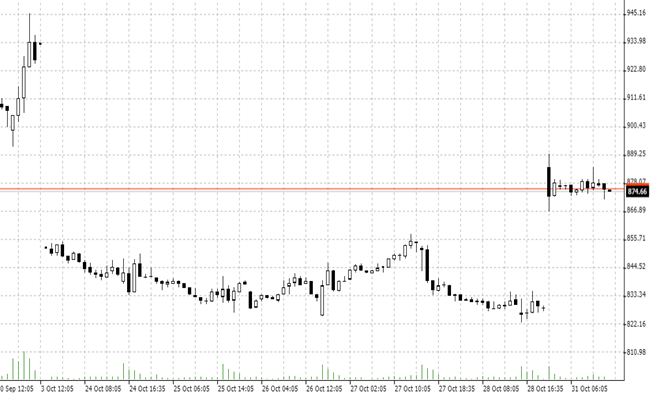

31.10.2022 – The time has come: Russia has stopped grain exports from Ukraine. In addition, a drought report from the USA is unsettling the market. The uncertainty is growing.
About two weeks ago, we warned you here of a coming wheat crisis. Since the weekend, nervousness has been on the rise, as a look at the hourly chart shows. The calm after the Ukrainian-Russian export agreement in July with the subsequent price plunge is in any case partially gone.

Quelle: Bernstein Bank GmbH
The reason: over the weekend, Moscow indefinitely suspended the grain deal brokered by the United Nations and Turkey. We had anticipated the move, which most media are calling “surprising.” Russia now justified the action by saying that possibly the attack with floating drones on the Russian fleet off Sevastopol was launched by a civilian Ukrainian step in the security corridor. However, the matter may have been planned for some time, as suggested by statements from Russian politicians two or three weeks ago.
Grain as a weapon
The consequences of the new Russian embargo are not yet being felt. According to media reports, dozens of grain freighters have wisely set sail for the Black Sea in recent days. Even this Monday morning, a dozen ships are said to have left the Ukrainian coast, according to the Ministry of Infrastructure in Kiev. We wonder if the Russians will attack these convoys.
In the medium term, however, the supply is likely to be in jeopardy. We suspect that we are in for a new major offensive by the Ukrainian army in the coming weeks. Winter is the best time for motorized attacks because of the frozen ground. Maybe the Ukrainians will even receive battle tanks from the West, who knows. The possible consequences for the wheat market: Russia will increasingly attack export routes over land in Ukraine in revenge for its own setbacks. Just as energy supplies are already being increasingly targeted to break Ukrainian morale. Moreover, the calling up of reservists does not suggest that Russian President Vladimir Putin is seeking a negotiated settlement.
Drought in the U.S.
Worrisome news for the grain market is also coming from the West. According to the USDA Drought Monitor, about 75 percent of U.S. winter wheat acreage is currently in drought. Gary Millershaski, head of the Kansas Wheat Commission, told the Bloomberg news agency that he himself has planted 4,000 acres to winter wheat, but will likely harvest only 1,500 acres – less than half – because of the drought. And there’s another worrying stressor for the coming months: the artificial fertilizer that is normally applied to fields now so it can soak in during the wet season is not being used by many farmers this time (yet), Millershaski added. That’s because it’s so dry that the fertilizer just disappears – “evaporate and disappear.”
Our conclusion from all this is that the stress factors for the grain market are growing. The unusually warm fall and the hope of a good harvest in Europe are still keeping a lid on prices. But it is quite possible that we will soon turn into a panic. Bernstein Bank is keeping an eye on the matter for you!
_______________________________________________________________________________________________
The content of this publication is for general information purposes only. In this context, it is neither an individual investment recommendation or advice nor an offer to purchase or sell securities or other financial products. The content in question and all the information contained therein do not in any way replace individual investor- or investment-oriented advice. No reliable forecast or indication for the future is possible with respect to any presentation or information on the present or past performance of the relevant underlying assets. All information and data presented in this publication are based on reliable sources. However, Bernstein Bank does not guarantee that the information and data contained in this publication is up-to-date, correct and complete. Securities traded on the financial markets are subject to price fluctuations. A contract for difference (CFD) is also a financial instrument with leverage effect. Against this backdrop, CFD trading involves a high risk up to the point of total loss and may not be suitable for all investors. Therefore, make sure that you have fully understood all the correlating risks. If necessary, ask for independent advice. CFDs are complex instruments and are associated with the high risk of losing money quickly because of the leverage effect. 68% of retail investor accounts lose money trading CFD with this provider. You should consider whether you understand how CFD work and whether you can afford to take the high risk of losing your money.7
